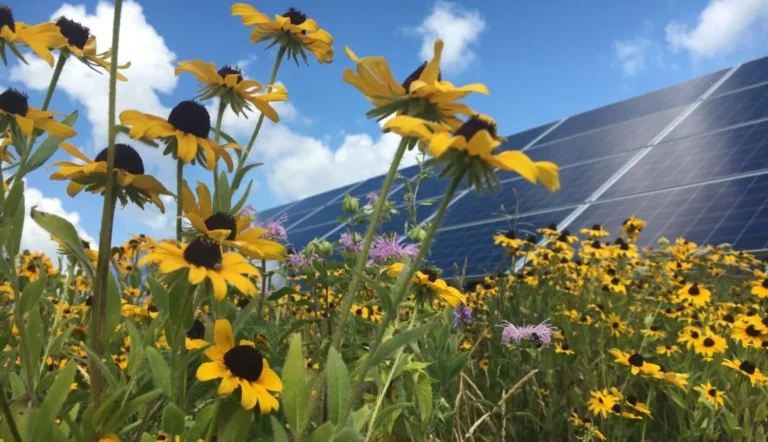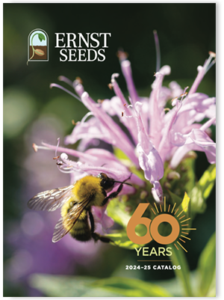by Rachel Sohmer
Solar farms can (and should) do more than produce clean energy.
Creating pollinator habitat at solar energy sites means renewable energy in a sustainable landscape that benefits us all. As the sight of rows upon rows of solar panels sprawling across the landscape becomes increasingly more common, we have good reason to feel hopeful. With an estimated 6 million acres of land in the U.S. predicted to be in solar energy production by 2050, the promise of a sustainable future powered by renewable energy appears within reach. But what are we actually seeing when we look at the typical solar farm? Solar panels, more solar panels, and…well, not much else. The conventional approach to solar energy development creates enormous expanses of gravel or turf grass that are short on beauty and have nothing to offer foraging bees and other key pollinator species. Moreover, this approach can generate a host of other problems that are, by nature, unsustainable.

The lifetime cost of maintenance for turf grass and gravel can be high compared with a native wildflower meadow.
Beyond the absolute lack of biodiversity — let alone pollinator support — turf grass and gravel are not as low impact or low maintenance as they may first seem. As Ernst Seeds horticulturalist Mark Fiely explains, the lifetime cost of maintenance can be high compared with a native wildflower meadow. Turf requires regular mowing, which typically means the use of greenhouse gas emitting mowers, and even gravel mulch must be managed for weeds and erosion. Stormwater runoff can also become an issue in these less porous landscapes, with knock-on damage to our waterways and groundwater resources. Soil conservation is yet another concern, as gravel and turf are more likely to require extensive site grading during installation. What’s more, without the cooling effect of evapotranspiration from plant leaves, localized high temperatures and reflected heat actually decrease the performance of photovoltaic panels. In short, while turf and gravel may seem like harmless, practical choices for solar energy sites, they can end up costing in more ways than one.

Research indicates that local communities are much more likely to support solar energy projects when they capture multiple benefits
Underplanting solar arrays with diverse, pollinator-friendly vegetation offers a sustainable answer to these concerns and much more. Indeed, given the large footprint of utility-scale solar energy projects, failing to leverage these sites for their potential environmental benefits is a significant missed opportunity. Consider, for example, that solar farms are often located in agricultural areas: solar-pollinator habitat creation is a natural opportunity to boost crop production in nearby farmland by attracting and supporting pollinators and beneficial predators. Regarding soil conservation, installing pollinator habitat beneath solar panels not only involves less site disturbance on average, it can also improve soil health over time and potentially help remove soil contaminants through phytoremediation. Research indicates that local communities are much more likely to support solar energy projects when they capture multiple benefits like these (and are aesthetically appealing!).
“Any time you plant pollinator habitat, you’re also making landscapes that are more attractive to beneficial insects and to songbirds and to people; landscapes that are more sustainable overall,” says Fiely. “We shouldn’t miss the opportunity for good stewardship and to be good neighbors.”
Sources
Beneath Solar Panels, the Seeds of Opportunity Sprout. NREL. (n.d.). https://www.nrel.gov/news/features/2019/beneath-solar-panels-the-seeds-of-opportunity-sprout.html.
Helmer, J. (2019, January 14). Solar Farms Shine a Ray of Hope on Bees and Butterflies. Scientific American. https://www.scientificamerican.com/article/solar-farms-shine-a-ray-of-hope-on-bees-and-butterflies/
Walston, L. J., Mishra, S. K., Hartmann, H. M., Hlohowskyj, I., McCall, J., & Macknick, J. (2018). Examining the Potential for Agricultural Benefits from Pollinator Habitat at Solar Facilities in the United States. Environmental Science & Technology, 52(13), 7566–7576. https://doi.org/10.1021/acs.est.8b00020


